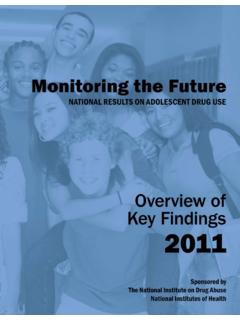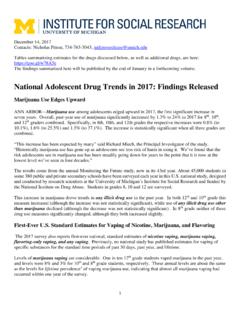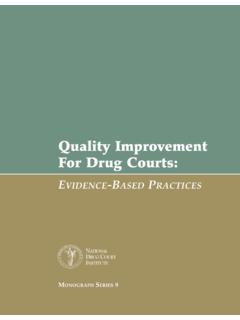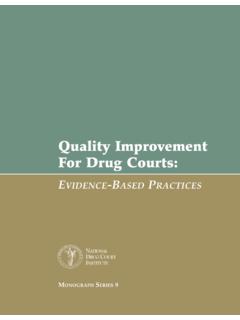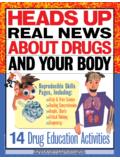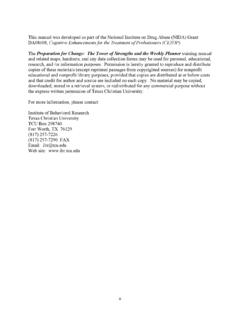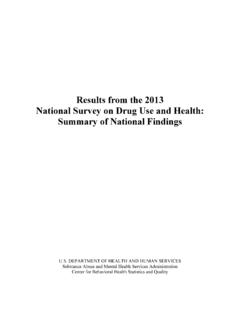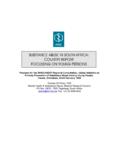Transcription of MONITORING the
1 MONITORING FUTURENATIONAL SURVEY RESULTS ON drug USE1975 20152015 OverviewtheSponsored by The national institute on drug abuse at The national Institutes of HealthKey Findings on Adolescent drug UseLloyd %. Johnston Patrick M. O MalleyRichard A. Miech Jerald G. Bachman John E. Schulenberg MONITORING THE FUTURE national SURVEY RESULTS ON drug USE 2015 Overview Key Findings on Adolescent drug Use by Lloyd D. Johnston, Patrick M. O Malley, Richard A. Miech, G. Bachman, John E. Schulenberg, The University of Michigan institute for Social Research Sponsored by: The national institute on drug abuse national Institutes of Health This publication was written by the principal investigators and staff of the MONITORING the Future project at the institute for Social Research, the University of Michigan, under Research Grant R01 DA 001411 from the national institute on drug abuse .
2 The findings and conclusions in this report are those of the authors and do not necessarily represent the views of the sponsor. Public Domain Notice All material appearing in this volume is in the public domain and may be reproduced or copied, whether in print or non-print media including derivatives, without permission from the authors. If you plan to modify the material, please contact the MONITORING the Future Project at for verification of accuracy. Citation of the source is appreciated, including at least the following: MONITORING the Future, institute for Social Research, The University of Citation Johnston, L.
3 D., O Malley, P. M., Miech, R. A., Bachman, J. G., & Schulenberg, J. E. (2016). MONITORING the Future national survey results on drug use, 1975-2015: Overview, key findings on adolescent drug use. Ann Arbor: institute for Social Research, The University of Michigan. institute for Social Research The University of Michigan Ann Arbor, Michigan Printed February 2016 Contents Click on any item below (in blue) to go directly to that page. Introduction ..1 Study Design and Methods ..3 Summary of Key Findings ..5 Specific Results by drug Any Illicit drug ..9 Marijuana ..11 Synthetic Marijuana ..13 Inhalants ..15 LSD ..17 Cocaine ..19 Crack ..21 Amphetamines and Other Stimulant Drugs.
4 23 Methamphetamine and Crystal Methamphetamine (Ice) ..25 Heroin ..27 Other Narcotic Drugs, Including OxyContin and Vicodin ..29 Tranquilizers ..31 Sedatives (Barbiturates) ..33 MDMA (Ecstasy, Molly) and Other Club Drugs ..35 Alcohol ..37 Cigarettes ..39 Smokeless Tobacco ..41 E-cigarettes and Vaporizers ..43 Small Cigars, Cigarillos, Large Cigars, and Tobacco Using a Hookah ..45 Steroids ..47 Subgroup Differences ..49 Lessons Learned ..52 Tables Covering All Drugs 1. Trends in Lifetime Prevalence of Use of Various Drugs for Grades 8, 10, and 12 Combined ..54 2. Trends in Annual Prevalence of Use of Various Drugs for Grades 8, 10, and 12 Combined ..55 3. Trends in 30 Day Prevalence of Use of Various Drugs for Grades 8, 10, and 12 Combined.
5 56 4. Trends in Daily Prevalence of Use of Selected Drugs for Grades 8, 10, and 12 Combined ..57 5. Trends in Lifetime Prevalence of Use of Various Drugs in Grades 8, 10, and 12 ..58 6. Trends in Annual Prevalence of Use of Various Drugs in Grades 8, 10, and 12 ..64 7. Trends in 30 day Prevalence of Use of Various Drugs in Grades 8, 10, and 12 ..72 8. Trends in 30 Day Prevalence of Daily Use of Various Drugs in Grades 8, 10, and 12 ..78 9. Trends in Harmfulness of Drugs as Perceived by 8th Graders ..83 10. Trends in Harmfulness of Drugs as Perceived by 10th Graders ..85 11. Trends in Harmfulness of Drugs as Perceived by 12th Graders ..87 12. Trends in Disapproval of drug Use in Grade 8.
6 90 13. Trends in Disapproval of drug Use in Grade 10 ..91 14. Trends in Disapproval of drug Use in Grade 12 ..92 15. Trends in Availability of Drugs as Perceived by 8th Graders ..94 16. Trends in Availability of Drugs as Perceived by 10th Graders ..95 17. Trends in Availability of Drugs as Perceived by 12th Graders ..96 Introduction MONITORING the Future (MTF) is a long-term study of American adolescents, college students, and adult high school graduates through age 55. It has been conducted annually by the University of Michigan s institute for Social Research since its inception in 1975 and is supported under a series of investigator-initiated, competitive research grants from the national institute on drug abuse .
7 The need for a study such as MTF is clear. Substance use by American young people has proven to be a rapidly changing phenomenon, requiring frequent assessments and reassessments. Since the mid-1960s, when it burgeoned in the general youth population, illicit drug use has remained a major concern for the nation. Smoking, drinking, and illicit drug use are leading causes of morbidity and mortality during adolescence as well as later in life. How vigorously the nation responds to teenage substance use, how accurately it identifies the emerging substance abuse problems, and how well it comes to understand the effectiveness of policy and intervention efforts largely depend on the ongoing collection of valid and reliable data.
8 MTF is uniquely designed to generate such data in order to provide an accurate picture of what is happening in this domain and why, and the study has served that function well for the past 41 years. Policy discussions in the scientific literature and media, in government, education, public health institutions, and elsewhere have been informed by the ready availability of extensive and consistently accurate information from the study relating to a large and ever-growing number of substances. Similarly, the work of organizations and agencies providing prevention and treatment services is informed by MTF. The 2015 MTF survey involved about 44,900 8th-, 10th-, and 12th-grade students in 382 secondary schools nationwide.
9 The first published results are presented in this report. Recent trends in the use of licit and illicit drugs are emphasized, as well as trends in the levels of perceived risk and personal disapproval associated with each drug . This project has shown these beliefs and attitudes to be particularly important in explaining 1 Prevalence refers to the proportion or percentage of the sample reporting use of the given substance on one or more occasions in a given time interval , lifetime, past 12 months, or past 30 days. For most drugs, the prevalence of daily use refers to reported use on 20 or more occasions in the past 30 days, except for cigarettes and smokeless tobacco, for which actual daily use is measured, and for binge drinking, defined as having 5+ drinks on at least one occasion in the prior two weeks.
10 E-cigarettes and some tobacco products are measured on number of days used in past 30 days. trends in use. In addition, trends in the perceived availability of each drug are presented, which at times have proven important to explaining changes in usage levels for some drugs. A synopsis of the design and methods used in the study and an overview of the key results from the 2015 survey follow this introductory section. These are in turn followed by a separate section for each individual drug class, providing figures that show trends in the overall proportions of students at each grade level (a) using the drug , (b) seeing a great risk associated with its use (perceived risk), (c) disapproving of its use (disapproval), and (d) saying that it would be fairly or very easy to get if they wanted to (perceived availability).


